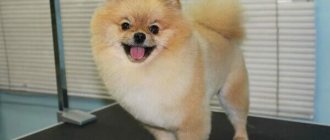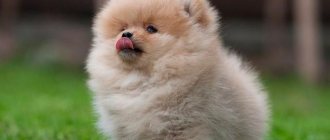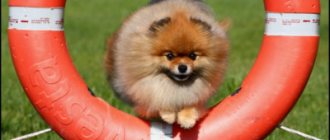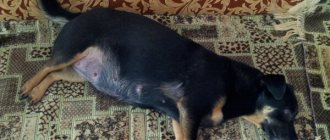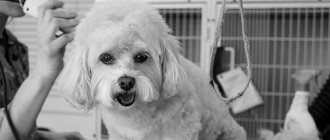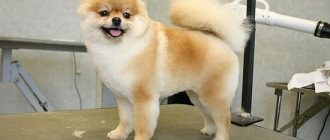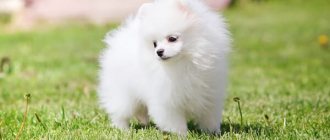Spitz training, its necessity, destroys the stereotype that small dogs are not very smart, which is why they are difficult to train. You can raise an obedient and devoted dog from a Pomeranian if you adhere to a systematic approach and take into account the breed’s character traits. Read more about the nuances of training Spitz dogs in our article.
Spitz training: basic principles and nuances
Character and temperament
Spitz are springs that are always active and cheerful. There is no need to wind them up; they will play and have fun all day long. We can say that these animals never lose heart.
Due to hyperactivity, children sometimes become uncontrollable.
Another negative trait of the breed is stubbornness. Spitz dogs do not resist out of malice, but because they do not want to waste time on training when it could be spent with other dogs or doing something else interesting. Therefore, training a Pomeranian should resemble a game.
Interesting! A well-trained Spitz restrains its emotional impulses in order to please its owners.
What to do if your Spitz is disobedient?
At the beginning of the educational process this will often happen. Without reacting to the words of the owner, an emotional dog can continue, for example, barking at passing dogs, showing aggression and stubbornness. In an attempt to calm the puppy, the sensitive owner pets and picks him up. In dog language this means: “You’re doing everything right, friend!”
There is a big difference between encouraging and giving in. In training, it is important not to confuse these concepts.
Feeling the support of a person, the dog will try even harder - bark until he is hoarse, rush at the object that has become the reason for aggression. After this, it will be difficult to explain to your pet that he is wrong. In order not to reduce to zero all the Spitz’s successes achieved in the process of education, incorrect behavior is stopped by the command “Ugh!” with a slight tug of the leash. Each dog has its own character and temperament.
Pomeranian bad behavior may have its own reasons. To know them, it is important to establish contact with your pet
It is worth understanding that a pet, like a person, has a bad mood and poor health. This can also be a reason for bad behavior. An attentive and friendly attitude towards your pet is the main condition for raising a healthy, obedient and happy dog.
Basic rules of training
The first condition is that the Spitz should be trained by a person who can be strict.
The second condition for effective training is that the puppy must not be pampered and even minor pranks and antics should not be allowed to get away with it.
Wrong behavior should be suppressed, correct behavior should be encouraged. In addition, there are other rules that will help make training more effective:
- Train when the puppy is not tired, but has just slept, recently eaten and is ready to play.
- Spitz remember emotional tone better than words.
- There is no need to skimp on treats, but treat your pet only according to its merits.
- If the Spitz is distracted, it is better to wait and start over.
How long to train
The only answer to the question: “How much training is needed?” – until the dog remembers the command. Repeat until the execution is brought to automaticity.
When training a simple command that does not require energy expenditure from the pet, it can be repeated 3-4 times a day. Serious commands, for example, “fetch”, which can be called an exercise for all muscle groups, 2-3 times a week, so as not to load the baby’s hind limbs.
The duration of each training session for a puppy should not exceed 10–15 minutes. The baby won't be able to stand it any longer; attention will begin to dissipate.
Rewards and punishments
The carrot and stick principle works for dogs too. Spitz dogs are great for the motivational method of training; they are ready to do anything for treats, praise and toys.
Correctly executed commands and good behavior are a reason to reward with tasty treats.
Punishment includes a stern look, a harshly pronounced nickname, deprivation of toys, treats, or even one meal.
The main condition is that the Spitz understands why he received the scolding.
Important! The dog should not be beaten, called names, or scolded loudly during training. This will only cause aggression. As a last resort, you can click the Spitz on the ear.
What should be prohibited
Spitz are decorative dogs that are unfairly classified as “couch soft toys.” In fact, these dogs are active, restless and disobedient, and require serious training, competent education and restrictions.
First of all, the owner must prohibit the puppy from gnawing and damaging things and furniture. There are toys for this.
Secondly, there is a taboo on sleeping with a person. The Spitz is allowed to sleep only in its house or on a lounger.
The third prohibition is begging. Any attempts to beg for a piece should be ignored.
Important! A few more conditions for getting a well-mannered dog: the Spitz should enter the room only after the owner, eat only when the whole family has left the dinner table, ask to go for a walk when the main time for walks comes.
Characteristics of Spitz
It is impossible to raise an obedient Spitz without understanding his psychology and temperament. First of all, it is worth learning that a dog thinks differently than a person. She does not build complex logical chains; she acts based on innate instincts and acquired reflexes.
It is on instincts and reflexes that the education of a Spitz is based. It is necessary to develop the dog’s natural qualities and build the right associations: “a good deed is reward”, “a bad action is punishment”.
The Pomeranian is an open, intelligent dog that quickly learns commands and tries to please its owner. Anyone can handle her training. But sometimes education stalls, and the dog turns into a spoiled tyrant.
The reasons for unsuccessful training lie in the disadvantages of the Spitz’s character. They:
- Stubborn. Favorites stand their ground to the last, and obey only when they understand that the owner will not back down;
- Dominant. If trained incorrectly, the pet will imagine itself to be in charge and will do everything to make the owner’s life revolve around its desires;
- Manipulators . In this, dogs have no equal, they subtly feel people’s emotions, understand how amazing they are and take advantage of it.
The German Spitz is an artist like no other. The dog skillfully presses on pity, guilt, and love of the owner. Among the manipulator's arsenal:
- sad or begging faces;
- grievances - going to another room, unwillingness to communicate with the owner, refusal to eat, play;
- barking, whining, howling;
- hysterics - Spitz squeal worse than piglets when trying to punish them, send them to their place, fasten a leash and other actions that infringe on the freedom of pets.
Keep in mind that Spitz love to play. Moreover, both puppies and older dogs frolic. Therefore, the classes are made humorous, they are conducted as if by the way.
The character of a German Spitz boy is more dominant and stubborn, while a girl’s character is flexible and affectionate. But both masterfully manipulate people.
When to start training
Dog handlers are still debating about the age of dogs and when to start training. Some people believe that the younger the Spitz, the easier it is for him to remember commands.
Others are sure that small dogs are absent-minded, often distracted, cannot concentrate, and therefore difficult to train.
One way or another, there is one general rule - they begin to raise and train a puppy from the first days of arrival in the apartment. And tricks can be taught later: at 3–12 months.
For training each team, there is an ideal puppy age when training is most effective.
Raising a puppy up to one year old
Old-school breeders often begin raising a Spitz at a specific age, allowing him to do whatever he wants as a child. This is wrong, since the baby should be raised from the moment it appears in the house after the nursery. He should immediately be told the rules of behavior, so as not to wean him off bad habits later.
Raising and training a Spitz is not drill or cruelty, but the establishment of understanding between the owner and his shaggy friend. The animal will have to instill the right skills gradually, gently, like a small child, introducing him to the world around him and the rules of living in it.
1-2 months
A pet at this tender age is just being taken home from the nursery, so he is introduced to the premises and his new family. The animal should be accustomed to its own name and to relieve itself in a diaper. The child must understand how to behave in the house and outside it, and learn prohibition commands.
3 months
You need to train a three-month-old puppy much more actively, adding street training to home training. In a park or forest, commands are fixed in the form of a game, and commands are added to encourage them to do what the owner requires.
4-5 months
The animal can successfully master the commands and skills included in the general training course. A five-month-old Spitz may simply be learning the skills necessary for later life, but is not yet able to show one hundred percent obedience.
6-12 months
At the age of six months, the baby begins to be trained seriously, teaching the entire range of basic commands. All inaccuracies that were previously made must be corrected within 12 months. The pet must be required to follow orders correctly and without delay.
Where to start training
While the Spitz puppy is small, he cannot perform complex tricks and physical exercises, but now is the time to develop his intelligence.
First of all, a dog needs brain training; the simplest exercises can be done at home.
First of all, the little Spitz must remember its name, then it will be easier to train and the lessons will be more effective.
Important! A Spitz puppy will obey during training when the owner proves his leadership by constantly showing rigor, punctuality, consistency in actions, confidence and patience.
Remember the nickname
A Spitz should remember its name at 3–4 months. The more often the owner calls the pet’s name, the faster the dog will learn it.
It is recommended not to use other names, affectionate nicknames and diminutive forms - only the full or abbreviated name that is used in everyday life.
The puppy is called by its nickname for a walk or meal, while playing or to attract attention. To be effective, they lure with a treat or toy, while calling the name loudly and clearly.
Toilet training a puppy
The puppy is toilet trained from an early age. When the baby enters the house, it is recommended to cover the entire floor with diapers, after removing the carpets. It is better to limit the space for the Spitz to an enclosure, an arena, or at least one room.
After 3-4 days you can leave 2-3 diapers. If you plan to toilet your Spitz at home, it is better to immediately install the tray in a convenient place and cover it with one of the marked diapers.
After completing the first course of vaccination, they begin walking. It is necessary to take the baby outside after every meal and sleep: at this time the dog wants to go to the toilet. It is recommended to walk for no longer than 10–15 minutes, during which time the Spitz should do its business.
When the puppy grows up and begins to communicate with other dogs, he will see that his brothers go to the toilet on the street and will try to imitate them. After each “success” the Spitz is praised and treated. Puddles in the house are punishable.
Features of puppy socialization
Socialization is an essential part of training, which will help the Spitz establish contact with the outside world. An unsocialized pet will grow up to be either fearful or aggressive.
After the veterinarian has given permission for walking, the Spitz is taken to quiet, calm places where he can “feel” nature. After 2-3 days, you can take a walk with him in an uncrowded park. The next stage is getting to know the dog park.
At first, it is better to go out during the day so as not to run into a whole pack of unfamiliar pets. When the baby gets used to it, it is good to continue training in the company of other dogs.
Next, the Spitz is introduced to the noisy streets, while being kept only on a leash. If the puppy gets scared, you can pick him up. An additional workout will be a trip on public transport.
Other useful skills
Commands are only a small part of what needs to be taught to a Spitz. It’s impossible to cover all the skills in one article, but there are key skills that you can’t do without.
Nickname
The first thing a kitten should remember in a new family is its name. It's easy: just repeat the name as often as possible, and after 3-5 days the Spitz will learn it.
It is important that when pronouncing the nickname, the puppy breaks away from his work, turns his head towards the owner and looks into the eyes for a couple of seconds.
Toilet
Until the puppy has learned to tolerate and relieve himself outside, he is taught to go to the toilet in a certain place in the house. The skill will also come in handy for adult German Spitz dogs - they won’t have to wait hours before going for a walk, and in inclement weather they can skip the walk altogether.
For this:
- lay out a dozen moisture-absorbing diapers around the apartment;
- as soon as the kitten spins in one place and sits down, they take him to the nearest toilet, wait until the baby copes, and praise him;
- day by day the number of diapers is reduced until there is only one left;
- after 1-2 weeks it is transferred to a tray;
- Gradually the diaper in the tray is cut off until a small flap remains - and then they throw it away too.
Dogs are not cats. While whiskers learn to go to the litter box in a couple of days at most, Spitz dogs learn this skill in weeks.
Avoid excessive barking
German Spitz are more talkative than a parrot. They bark shrilly and loudly at the slightest provocation. The order “Quiet” will help calm down the flow of words. But it doesn't always work.
You can show that you don’t like yapping:
- leaving the Pomeranian alone;
- stopping barking and scolding the dog at the first yelp;
- distracting your pet with toys and treats;
- sending the pet to its place.
Uncontrollable barking is a sign of anxiety. It will help to exclude him from being examined by a veterinarian for possible diseases, going for a long walk, and solving psychological disorders.
The ability to be alone
German Spitz are very attached to their family, it is difficult for them to stay at home alone. Therefore, when the owners leave, they worry, bark, howl, and spoil things.
In order for the pet to easily tolerate loneliness, it is taught to be alone from puppyhood:
- lock the dog in a separate room;
- as soon as he gets worried, they order “No”;
- if it follows people, they calmly, silently return them to their place.
Such demonstrative abandonment is practiced every day, constantly increasing the time without owners. If a Spitz sits quietly for half an hour, it will withstand many hours of separation.
Socialization
It is impossible to raise a Spitz without socialization. In the family circle, a dog can be three times charming, but if he does not know how to normally relate to strangers, animals, and sudden events, no amount of training will help.
Spitz socialization begins at 3-4 months, when the vaccination quarantine ends. The dog is introduced to:
- children;
- other people's pets;
- unknown adults;
- travel by personal and public transport;
- noisy places;
- veterinary clinics and other institutions that you will have to visit frequently.
When they go out for the first time, they take treats with them. They are fed periodically - this way the dog will not worry and will focus on the owner. It is important to ensure that the Spitz reacts to surrounding people, animals and unfamiliar places without fear or aggression.
Command training
Almost all commands for dogs are not just entertainment, but signals for control and control. Without their knowledge, the Spitz will not be obedient, and this can lead to an accident. Commands allow you to control your pet’s behavior indoors, in crowded places, in transport, during hygiene procedures, and examinations.
It’s a good idea to start training a small puppy at home - training with the owner will not cause him stress. And the schemes and recommendations developed by dog handlers will help you teach your Spitz commands.
To me
Take the dog on a leash, walk away its entire length and say the command “Come to me!” The Spitz did not pay attention to this - lightly pull the leash and lure the dog with a treat. Repeat until the puppy comes up without tugging on the leash.
Near
This command is necessary for a safe walk in crowded places. Command “Near!” and pull the leash towards you, bring the puppy to your leg. Spitz tries to speed up and moves away - repeat the command and algorithm of actions. Encourage obedience.
Sit
A classic static command, mastering it is a prerequisite before moving on to complex tricks.
Stand at the side of the Spitz at a short distance, take him on a leash. Say the nickname and the command “Sit!”, and then gently press on the lower part of the lower back. Pull the leash up and away from you. Be sure to praise the animal for correctly following the command.
The second training option: kneel in front of the Spitz, raise a treat over it, and order “Sit!” and press lightly on the croup. Then give your pet a treat.
Place
A mandatory command that allows you to quickly calm the dog down and send it to bed. The Spitz already has a small house or a personal corner. Say the command “Place!”, point to the bed and take the baby to it.
The second option: stand near the lounger, raise a treat over it, call the Spitz by name and say “Place!” After the dog jumps onto his bed, give the treat.
You can't (Ugh)
This is a mandatory signal that must lead to action. The command is pronounced strictly and once. If the Spitz does not listen, he is punished.
Team training goes like this. Offer and feed your pet a piece of treat. After a minute, show the same one, holding it tightly with your thumb in your palm.
When the Spitz wants to take him away, say “No!” or “Ugh!” and click the dog on the ear. You need to achieve such an effect that, on a signal, the puppy turns its head away from the hand.
Give
While playing, give the Spitz something to grab; it’s more convenient if the toy is a rope. After a while, look sternly at the dog and say “Give!” Pick up the item. As soon as the baby gives up the rope, praise him, give him a treat and return the toy.
If the dog does not give up, slow him down a little, repeating the command strictly. You cannot pull the rope; the Spitz will only clench its jaws tighter and begin to get angry.
Quiet and voice
These two commands are studied in pairs from about 2 months. When the puppy starts barking, for example, during play, repeat “Voice!”, “Okay, voice!” several times. and give a treat.
The puppy continued to bark - say “Quiet!” and squeeze his mouth with your hand, then give him a treat.
Lie
Training for this command begins at 3 months. Command “Sit!”, wait for execution. Say “Lie down!”, pressing on the withers with one hand, and lowering the treat to the ground with the other so that the Spitz reaches for it. After following the command, allow him to eat the treat.
Stand
Not the most favorite command for Spitz dogs, because it is associated with hygiene procedures and inspection. It is not necessary, but helps during grooming and veterinary appointments.
When the Spitz is sitting, go up to him and say: “Stop!” At the same time, support the puppy under the belly with one hand, and pull the collar with the other.
When the dog gets up, praise him and give him a treat. It is important that he does not take unnecessary steps.
Give me your paw
One of the simple “entertaining” exercises. It is done like this:
- put a treat on your palm and let the spitz sniff it;
- hold the treat in your fist and raise it to the level of your pet’s nose;
- when he tries to tap your hand with his paw, open your palm, say: “Give me your paw,” and feed the treat to the dog.
Aport
This command is the most fun and interesting for Spitz, but they begin to study it when the baby reaches 6–7 months and knows the “Near!” signals. and “Come to me!”
The first step is to teach the dog to take the thing, hold it and give it back on the command “Give!” Tease the Spitz with a stick or other inedible object, when he tries to grab it, say “Fetch!” and allow to take, encourage.
Then wait 3-5 seconds, say “Give!” and pick up the item and treat the pet with a treat.
The second step is learning to walk with an object in your teeth. When the Spitz grabs the wand, take a few steps away from him and call “Come to me!” or “Nearby!” Repeat the manipulation with the command “Give!” and praise the dog.
The last stage is to teach how to lift an object. Take the Spitz on a leash and throw the object so that it is in the animal’s field of vision. Command “Fetch!”, lead to the object, point at it and repeat the command again.
If the dog does not react, move the object. As a last resort, give it to your pet’s teeth. Then repeat the command “Give!” and give the baby a treat.
Bow
A Spitz can learn this optional command after a general training course. It is not functional or important, but develops coordination and thinking.
Stand in front of your pet, lower the treat to the ground and invite the dog to take it. When the Spitz tries to bend over or lie down to take the treat, place your other hand under his belly and say “Bow!”, and then give him a treat. Repeat until the Spitz understands that it is forbidden to lie down.
Basics of education
The first and main rule for training any dog is to establish hierarchical relationships. Dogs are social animals. And they perceive the family as a pack, where each member will play his role - from the owner to the hamster.
The roles are distributed as follows: alpha - the owner, after him - the spouse, parents, children, then - the rest of the pets, and at the end - the German Spitz. This is the only way the dog will obey.
In order for the dog to consider the owner as the leader of the pack, they follow simple training tips:
- feed the pet after they have eaten themselves;
- a person enters and exits first;
- on a walk, the owner walks ahead - the dog runs slightly behind, does not rush forward, does not pull on the leash;
- you cannot feed the dog from the table, or allow him to sleep on the bed - these are the attributes of a leader;
- when the game starts and ends is determined by the owner;
- biting, snarling, attempts to dominate are stopped immediately and harshly.
The rules are set once and for all. If a Pomeranian is not allowed to lie on the sofa, an exception cannot be made, even if he is sick. What the dog is allowed to do once, he will certainly repeat many times.
A daily routine will help in training a German Spitz. They determine the time of awakening, walks, classes, games, hygiene procedures, feeding, and rest. This makes it easier for your pet to navigate, and he develops the right habits.
How to stop biting
Puppies during the period of changing teeth (3-4 months) are looking for something to bite. And, usually, they choose the legs and arms of the owner. But this behavior will become a habit and subsequently will no longer be funny if the Spitz is not weaned from biting at an early age.
First of all, the baby must understand that human body parts are not a toy. Therefore, when the dog wants to bite someone, offer him a ball or a squeaker.
When a puppy bites his fingers not on purpose, but out of interest or boredom, it is better not to pay attention to it, but not to give him a reason to behave this way next time.
There are developed training schemes that help to wean a Spitz from biting.
- When the puppy is calm and well-fed, hold your hand in front of his muzzle. If the baby does not react, he should be praised and treated with a treat. Otherwise, pull your hand back and sternly say: “You can’t!” The training is carried out 2-3 times daily.
- If your Spitz wants to bite, hide your hands behind your back. When he calms down, snap your fingers in front of his nose and give him a treat. Repeat several times.
Tips from dog handlers for self-study
If you decide to start raising a Pomeranian on your own, dog experts advise adhering to the following rules:
- consider the character of the pet;
- if difficulties arise, seek help from specialists;
- do not make concessions or exceptions to the established rules for your Spitz;
- Walk your pet daily to release its energy;
- avoid physical punishment;
- engage in social adaptation of your pet;
- do not separate play and learning;
- control barking;
- do not succumb to provocations from the animal and do not allow it to dominate.
In training
Once you have acquired such a beauty as a Spitz, don’t put your upbringing on the back burner. Follow the recommendations of specialists and remember that the future character of an adult dog and the quality of your life together depend on the quality of training.
How to stop barking at home
Stopping a Spitz from barking at home is one of the most difficult training tasks. Constant barking for no reason is a feature of the breed. You need to teach your pet basic commands to make it easier to control it.
It is recommended to avoid noisy entertainment (with a tambourine, rattle, loud squeakers), and arrange a place for the Pomeranian away from the front door. The baby needs to be given enough attention so as not to make him sad.
Important! A dog barks when no one is home, which means she is bored. It is recommended to leave the radio on and close the windows and curtains.
About the hierarchy in the house: who is in charge?
How effective the training will be largely depends on how quickly the pet learns to comply with subordination. From the moment the dog appears in the house, it must understand that the authority of the owner is an unconditional and constant value. This is not as easy to achieve as it seems at first glance, because the appearance and behavior of the Pomeranian is conducive to being loved and pampered, and even turning a blind eye to pranks.
You need to say goodbye to the involuntary desire to constantly pamper everyone’s favorite
The Spitz grasps everything on the fly and can quickly assess the situation. When the dog realizes that he has become the leader among people, he will never give up leadership voluntarily. Only an experienced dog handler can change the behavior of an adult dog that imagines itself as a leader. To avoid such a situation, you should raise your Pomeranian systematically and patiently.
Consultations on education can be taken from both breeders and trainers
The breeder from whom the puppy was purchased can provide invaluable assistance in this matter. People who devote themselves to professional dog breeding, as a rule, are well aware of the character traits of the breed and do not refuse owners advice.
How to train a Spitz to be alone
Spitz are one of those breeds that cannot be ignored by their owners. But in city life, the pet has to stay at home alone. Teach him to be independent from an early age so that the dog feels comfortable alone.
You can leave your dog alone at home from the age of 3 months, while limiting its space. They purchase spacious playpens (for children or special ones for dogs) or simply block the passages to the rooms.
Next to the puppy you need to place a bowl of water, toys, a diaper - a home toilet and a lounger. It is better for the baby not to sit on his own for longer than 2–3 hours.
Training at 4 - 5 months
By this time, the Pomeranian Spitz puppy has already become accustomed to your home and usual walking areas, and no longer needs your support and care so much. He begins to flirt with other dogs, pretend that he does not hear you when you call him, and show a certain persistence and disobedience when performing various commands.
This means it's time to move on to full training . In classes at this age you can already be persistent and demanding. At the same time, the most important thing is not to overdo it, remember that classes should bring joy to both you and your dog, and only then you can achieve the desired result.
Required commands in 4 months
What commands are practiced by a Pomeranian Spitz puppy at 4 months:
- Calm movement next
to the owner with and without a leash, with landing when stopping, with a change in pace and direction of movement - Return to you
on command - Exposure
in a free or certain position (sitting, lying, standing) - Indifferent attitude towards treats scattered on the ground
- Inhibitory command
to stop unwanted actions - Execution of a set of commands “sit”, “lie down”, “stand”
at a distance and near the leg, when giving commands by voice and gestures - Stop barking
on command.
Recommendations from dog handlers
Spitz are always puppies, they love to play and have fun, so getting them interested in training is not so easy. But dog handlers know how to solve this problem:
- Training should be turned into a game using treats, attributes, and obstacle courses.
- The duration of one exercise is no more than 10 minutes; the more often the Spitz’s attention is switched, the longer he will listen; To consolidate, it is better to return to the exercise at the end of the workout.
- Each individual requires an individual approach. Usually animals are better trained in a group, but some Spitz puppies get lost in the company of other pets and cannot concentrate.
- When a Spitz does not understand or does not want to follow a command, you cannot hit or shout at it; it is better to repeat the exercise again.
- The dog should not be overtired; it is better to train it an hour after eating and walking.
Let's stop barking
Pomeranians are big fans of barking, but neighbors and passers-by on the street are unlikely to like it. This means that you need to wean your puppy from such a bad habit as excessive barking.
It should be remembered that:
- A dog should be scolded for barking excessively, but it is unacceptable to use physical methods of punishment.
- It is best, as soon as your Pomeranian starts barking at neighbors or passers-by, to attract his attention with a toy. Just don’t immediately play with your pet or, especially, give him a treat. Then he will decide that his owner rewarded him for barking loudly. Then the process of weaning from this habit will take much longer.
- When a Spitz barks for no reason, you can spray water from a spray bottle into its face. You just need to make sure that it is water splashes and not a stream of water. It can cause harm to the dog or greatly frighten it.
- If a Spitz barks at people passing by the apartment door, then you need to force the dog to stop this action. Then ignore him for some time, thereby showing your dissatisfaction. For Pomeranians, most of whom are very people-oriented and cannot do without communicating with their owners, this will be the most severe punishment.
- To wean older puppies from barking, you can use the “No!” commands. and “Place!” Only they need to be served not at the same time, but with some interruption, so that the dog does not think that the owner is forbidding him to go to the place.
Is it difficult to train a Pomeranian?
The Pomeranian breed is famous for its intelligence, and these small dogs are usually not difficult to train. The culprit of gaps or defects in upbringing most often becomes the owner himself.
Common mistakes in training:
- Lack of human persistence. The pet instantly “sits on its head” as soon as the owner gives in once.
- Elevation of the little Pomeranian cunning man to the rank of “master of life.” He loves to dominate. The slightest mistake in training, and the whole life of the family revolves only around the furry tyrant.
- Tenderness and delight at the dog’s appearance. A smart manipulator subtly senses the emotions of those around him, understands when he is admired and takes full advantage of this, forcing the owners to “dance to their tune.”
When training, you need to be prepared for insubordination, cunning and hysterics. If the owner’s actions somehow infringe on the pet’s freedom or desires, a gala concert is inevitable. However, high intelligence helps the dog quickly remember commands and correctly assess the “carrot and stick” situation.
How to teach to go potty?
Puppies raised in a kennel are already toilet trained, but in a new place you will still have to work a little:
- To avoid damage to carpets and rugs, remove unnecessary elements during training, because the small size of the breed will not greatly brighten up the scale of the “wet tragedy”.
- Buy a set of disposable diapers. When trying to relieve yourself, try to have time to transfer the Spitz to the prepared diaper and praise if successful. Any training is based on iron patience.
- Do not scold or punish the Pomeranian in case of failures. New smells frighten the puppy and require adaptation to understand the new latrine.
- After the puppy gets used to the diaper, you can put the tray in its usual place. For better results, place a wet diaper there so that the Spitz associates the new object with the action expected from it.
- Each time, move the tray closer and closer to the toilet until it is in the right place.
Strict adherence to these steps will allow you to toilet train your Pomeranian Spitz even in puppyhood without any problems.
Teach discipline persistently!
When you need to achieve unquestioning obedience from a Spitz, you don’t need to be afraid of harsh training methods. For example, combine a treat with simultaneous control of the dog using a 10-12-meter nylon cord or a jerk chain.
The procedure is as follows:
- At first - a game, a casual walk.
- When the Spitz begins to get distracted and forget about the cord, you should give a command and pull the cord, attracting the dog to you. The jerk should not be strong, but sharp.
- As soon as the dog approaches, be sure to encourage it, caress it and let it go for a walk.
- If the jerk does not work, you need to pull a little harder several times in a row without repeating the command. The order is pronounced once, but clearly and loudly.
- After approaching, the dog needs to be rewarded.
Additional training tips
- Do not forget that the command “Lie down” is given before coercion, and the treat is given only after the pet has laid down.
- If the dog gets up without your command, be sure to return it to the desired position, while repeating “Lie down!”
- Avoid excessive roughness when applying pressure.
- Do not try to immediately get great endurance from your dog.
- Do not place your puppy on dirty or wet ground during the early stages of training.
- Release the dog with the command “Walk”, not “Come”. The fact is that “Come to me” is a pleasant command (if you have trained the dog correctly), so it is much more difficult for a pet that is accustomed to being released with this command to wait. As a result, endurance becomes significantly worse.
What can you teach a Pomeranian?
It is worth starting training with the basic commands. You cannot teach a bear, fox, or toy Pomeranian to sit or run next to its owner before the puppy has mastered the basics well.
Knowledge and skills developed through proper training.
| Basic Commands | Characteristics of the actions of the owner and the dog |
| "Name" | The puppy must remember its name and respond to it unquestioningly. You should not choose an intricate long name for your pet, so as not to complicate training. |
| "Ugh!" | This is not a cry of disgust, but a warning of danger. When a puppy shows attention to something dangerous (object, food, situation), you need to give a command in a stern voice with clear articulation. In addition, you can slightly tighten the leash (do not pull too hard). |
| "It is forbidden" | This is not the same as “Ugh!” The command means that the dog must stop the action that is happening at the moment (barking for no reason, begging, trying to dominate, etc.). The command must be given in a confident tone that does not allow for objections. |
| "Place" | The puppy must know where this very place is. Before training, you need to arrange for him to lie down. The first time the command is performed by the owner himself (pick up the pet, carry it to its place and be sure to praise it). |
| "To me" | The command is pronounced confidently, kindly, and is accompanied by a slight pull on the leash. When reinforcement with a leash is no longer required, you need to praise the puppy especially actively. |
| "Sit" | This is an intermediate option between simple and complex commands, the beginning of raising a truly disciplined dog. The dog should stand at the owner's side on a short leash. Then they pronounce the puppy’s name and confidently give the command, while lightly pressing the dog’s sacrum. Use a leash to slightly lift the front part of the body. When the Pomeranian follows the command, he is sure to be praised and rewarded. |
Command "Near!" - this is the next level, allowing the owner and dog to feel confident in any crowd of people. The dog should stand close to the person’s left leg (pull it slightly with a leash). When moving, the puppy may change direction or speed. The owner carefully corrects the behavior with the help of a leash. Every success is sure to be rewarded.
Where to conduct classes
The “Down” command does not pose any serious physical or mental difficulties for the dog. Therefore, you can start training as soon as your four-legged friend arrives to you and gets used to his new home.
You can train both at home and outside. The main thing is to choose a calm and quiet place where the dog will not be distracted by extraneous sounds or other animals.
The place should be clean, protected from drafts and warm. Because lying on a dirty and damp surface will be unpleasant for the animal. It is better to choose dry soil or any room.
To carry out the “Lie down” command, the pet will not need to move much: on the contrary, it will only sit and lie, so it should not freeze. Most owners teach the dog the skill of grooming within the walls of his home.
Features of raising a Pomeranian Spitz
Among the ancestors of the Pomeranian Spitz there are excellent hunters, strong sled dogs and reliable guards. The Pomeranian is an ornamental breed, but its psychology and character are inherited from natural leaders, the leaders of the pack. The dog is stubborn, independent and very smart. He is also a cunning manipulator with a sweet little face.
If you raise a baby without proper training, the Pomeranian very quickly assesses the situation and begins to shamelessly take advantage of its privileged position. He loves to stage “performances”, demonstrates resentment, and is capable of throwing a hysteria worse than a tragic actress. And what is an unhappy face worth if the poor dog is not given a tasty morsel?
Loud yelling and corporal punishment will not solve the problem of training a Pomeranian. It is necessary to establish a connection between the animal and the person, to learn to understand the needs of the pet. Persistence and encouragement instead of shouting and punishment will give good results, and most importantly, they will bind the owner and pet into a strong friendship.
